Features of growing nasturtium on the balcony

The peculiarities of growing nasturtium on the balcony are not so much in complex agricultural technology (they note undemanding and ease of care), but in compliance with the planting rules. To ensure stable flowering, you need to take into account the nuances of planting and reproduction. A different approach to wintering - for perennials and annuals. Breeders have bred many species that differ from their modest predecessors imported from America. Florists have at their disposal tricolor, multi-leaved, large and other varieties with beautiful names, huge decorative potential.
Selection of type and variety
Nasturtium on the balcony is a practical and modern solution, behind which lies the boundless potential of possibilities. In Europe, the plant gained popularity several centuries ago and was actively studied and improved by breeders. In the USSR, a short-term peak of demand came in the middle of the last century, and then changeable fashion began to dictate other trends. Recently, it has become widely used as a balcony decoration.
It was found that flowers, of which there are already several dozen species, can be grown without problems at home on a windowsill, and not only in a front garden or vegetable garden. The cultivated species bear little resemblance to their humble American predecessors. The home designer and amateur florist had a whole arsenal at their disposal.
A small trophy (this is how the Latin name is literally translated) provided numerous opportunities for ennobling a front garden, a balcony or a loggia, a house wall, an open terrace, a veranda, a multi-tiered flower bed and other elements of spring-summer decor that lovers of beauty love to surround themselves with.


The listing of numerous species is not very informative, so the choice must be made based on color preferences and the area in which the owner intends to distribute the plant.
- Indoor (tuberous) - perennial culture, the shoots of which spread up to 2 meters. Almost any species can be grown at home if you dig it up and transplant it into pots. It can be used for propagation by cuttings, as a medicinal plant, brew dried flowers in tea, and even pickle tubers. In America, fields are still being planted for the consumption of tubers.

- Ampelnaya - an excellent decorative solution. This type is suitable for decorating balconies, gazebos, arches and other buildings. Vertical landscaping is especially effective with the use of foreign (Canarian) nasturtium, which is considered the most famous variety. It also has other purposes - the dense vegetative mass on the stems allows it to be used as a ground cover plant. Benefits - beauty, aroma, space saving. The disadvantage is late flowering (begins profusely, but only in the middle of summer).
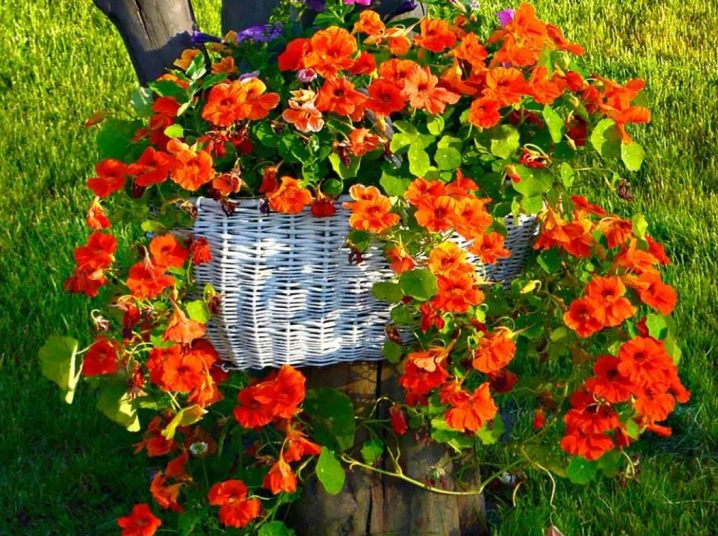
- Curly - the most common in domestic practice. The colors are in a sunny range: red, orange and yellow flowers in all the variety of shades. There are terry and semi-double, in different combinations (with increased decorative effect), but simple, monotonous are also incredibly good with proper care. The most famous are five-leafed, many-leaved, azure and tricolor, from one and a half to 3 m, with a flower diameter of 3-6 cm.They bloom from early summer to early autumn frosts.


The potential of this plant has not yet been fully appreciated and fully disclosed. Of the 90 known species, 2.5 dozen can be found for breeding, and in addition to the main varieties, there are also numerous hybrids with useful features. They are so picturesque that they don't need to be combined with other plants. Recommendations are not needed "Golden ball", cultural hybrid nasturtium with decorative flowers and leaves of unusual color, liana-shaped, tall (bush) and dwarf, "Cherry rose" and "Black velvet". These are worthy representatives of small nasturtium. Unpretentiousness, beauty, long flowering - these are just some of the arguments in favor of using nasturtium in the most variable types of design and styles of landscape design.
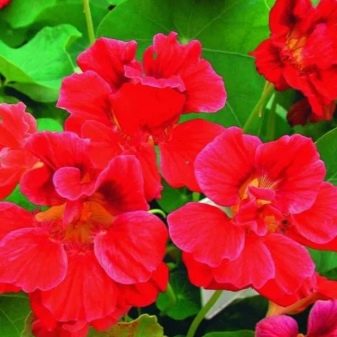

Landing nuances
The herbaceous crop can be planted as an annual (it does not survive in winter in temperate climates), kept as an indoor perennial plant and at the same time used as a mother plant for decorating a balcony. It is grown by seeds for seedlings in order to get abundant flowering as early as possible, or in a similar way - directly into the open ground.
Low-growing, long-leaved, ampelous species are grown in boxes, pots, flowerpots, near arches and special trellises. The volume of the plant determines the type and subtleties of care - some of them have to be tied up. You can use some of the shoots for propagation by cuttings. Hybrid seeds are purchased in specialized stores. Common species can be harvested at home, but hybrid varieties do not retain their characteristics.
Cuttings are an excellent way to breed planting material, one of three used by flower growers (except for seedlings and seeds in open soil). If you plant several pieces in advance (usually this is done with rare and expensive varieties), you can rooting in a container with water or in wet sand.


Care rules
The plant requires a differentiated approach to watering at different periods. It is also said about the obligatory arrangement of the drainage layer when breeding in hanging pots.
Transplantation for the winter is carried out together with an earthen lump, then after wintering the grower will have enough material for grafting and decorating the balcony with an annual. Low-growing nasturtium is grown in flower beds or flowerpots to decorate open terraces, patios and local areas. Curly nasturtium can be used on decorative trellises, as a zoning aid, on gazebos and arches.
With the spread of the fashion trend, there are more and more suggestions and tips on how to properly grow nasturtium. You can read them on forums and websites for flower growers.

Conditions
Despite the claims that the cultivation of an ornamental plant is not difficult, it does not tolerate a lack of light, so it is better to place it on balconies located on the sunny side. If there are none in your case, then additional lighting should be organized.
For the culture in question, cold and strong gusts of wind are unacceptable, therefore, it is worth taking the pots out to the balcony only when the low temperature has passed.
Ampelny - in a flowerpot - can be placed in the depths of the balcony or suspended on its outer side, but at the same time, one must take into account the frequent direction of the wind and the degree of illumination on the north and west sides.

Neighbors
There are many options, proven through practical experience, to provide nasturtiums with a comfortable existence, and at the same time create harmonious compositions that delight the eye. You can safely use pelargoniums, pansies, bells, petunias and snapdragons. There are other options, for example geranium, but aesthetes and lovers of beauty are sure that capuchin should not be planted next to too bright and fragrant plants that "shade" its delicate and delicate charm.

Watering and feeding
Nasturtium requires intensive watering only during certain periods of its development. Until flowering begins, it can be moisturized every day or every other day. You cannot do this in sunny weather, the preferred time is in the evening. Even with drip irrigation, the necessary conditions remain unchanged. The plant will need a nightly procedure on hot summer days. With the onset of flowering, only the top layer of the soil is moistened, and water is added only if the soil is dry. Overdoing it with this, you can reduce the intensity of the setting of flowers and increase the growth of vegetative mass, cause rotting of the root system.
Top dressing is advised to be carried out with nitrogen compounds (nitrofoskoy, agriculture), but only during the flowering period. The solution is prepared weak, so that there is no oversaturation of the soil.
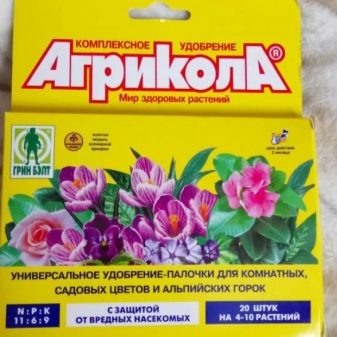

Diseases and pests
Noticing that nasturtium is not growing or showing signs of illness, you need to look at it for diseases or ill-wishers from the insect world. It can be aphids, whiteflies, spider mites, bacterial wilting. Leaf damage is caused by both diseases and pests. For the correct choice of means of struggle, an accurate definition of the cause is necessary.
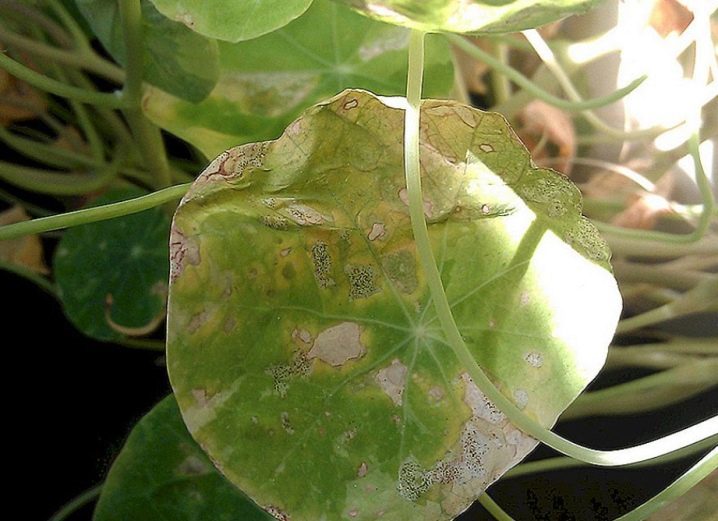
Beautiful examples of balcony decoration with flowers
They can be observed, and walking along the city streets, and studying the photos posted by users:
- nasturtium "Nymph" in pots wrapped in material and wire supports;

- growing by direct additive in boxes in combination with other crops;

- a chic loggia in a private house, decorated with hanging pots;
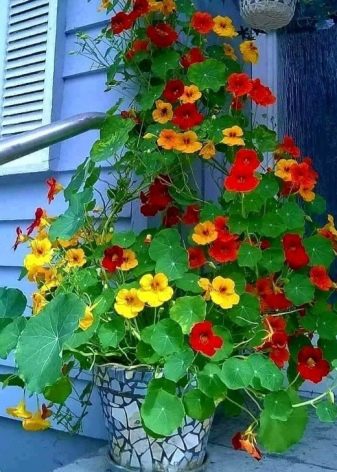

- a spectacular composition in spacious structures on the wall of the house, shading the French window;

- a flower bed of tires, decorated with stunted nasturtiums, next to a white decorative flowerpot and other ornamental plants.
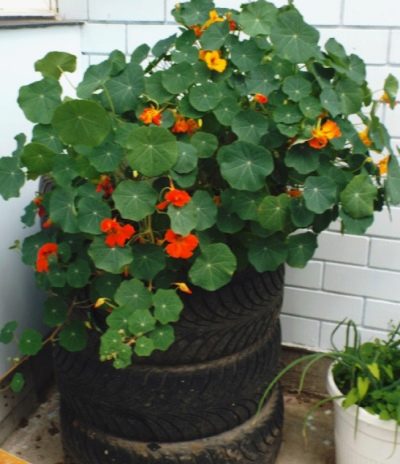
The manifestation of imagination is an indispensable condition that will allow you to design balconies or other areas that require refinement as effectively as possible. In a decorative solution, you can use not only one type, but also different ones - to create a more beautiful combination.






































































































The comment was sent successfully.